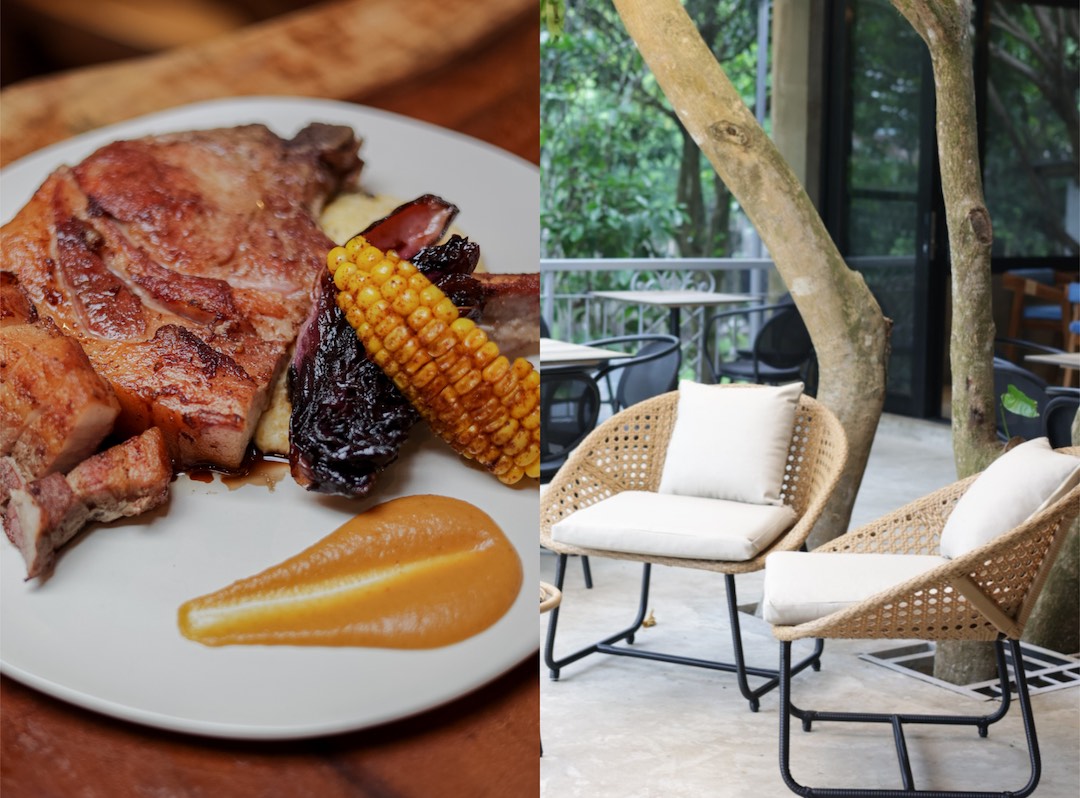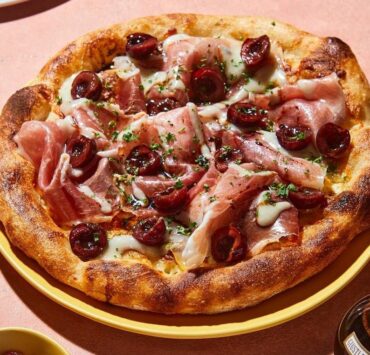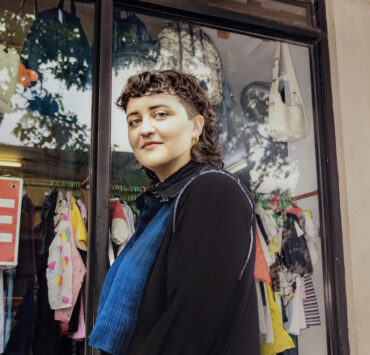The Fatted Calf’s story so far reads very much like a novel. Jayjay and Rhea SyCip, a married couple who also happen to be a pair of chefs, open a farm-to-table kitchen in Silang. The space happens to be the same place that they once visited—thanks to getting lost—while they were still dating years earlier.
They were able to lease the property for relatively cheap, and within a year of opening, quickly became a go-to destination for their loyal patrons and friends.
That is, until 2020 struck.
The year that shall (hopefully) never be repeated brought a volcanic eruption and a pandemic that all eventually contributed to the shuttering of the restaurant’s first iteration. But even after announcing its closure on their social media, excited diners still flocked to the padlocked gate hoping it was all a misunderstanding.
And then, the community that helped them get started helped them get back on their feet.
Its latest iteration (which will open to the public in June) stands along the Tagaytay-Nasugbu highway, on the same road that other restaurants of the same caliber occupy.

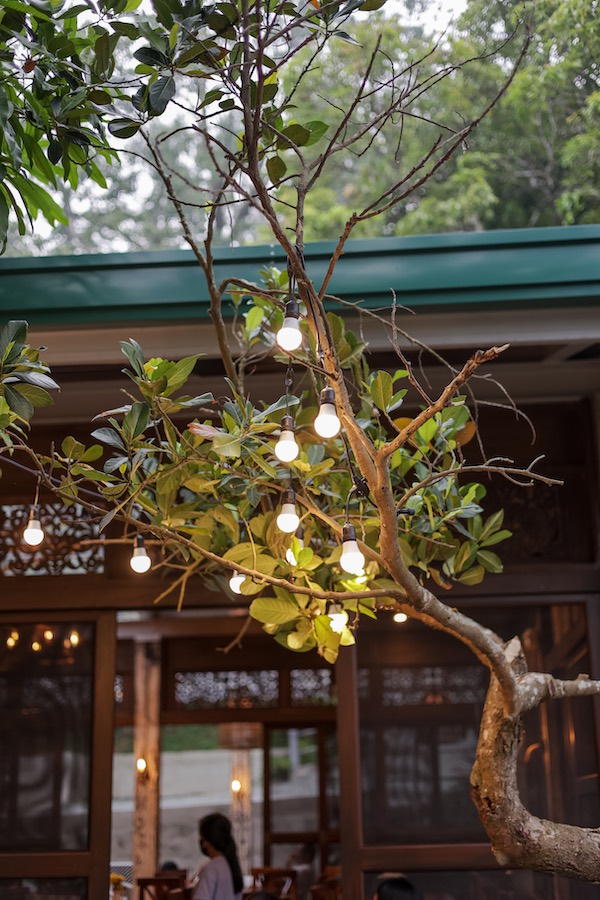
New and old come together in the new space. Concrete and antique wood details meet in the restaurant to give it a modern yet homey feel. The restaurant takes great advantage of the breezy Tagaytay weather with their large doors that let the fresh air in.
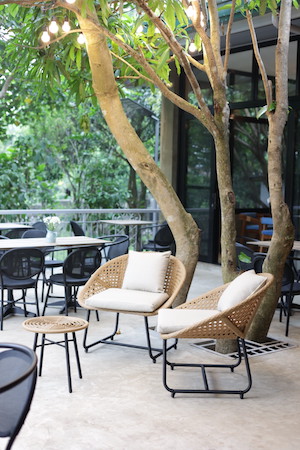
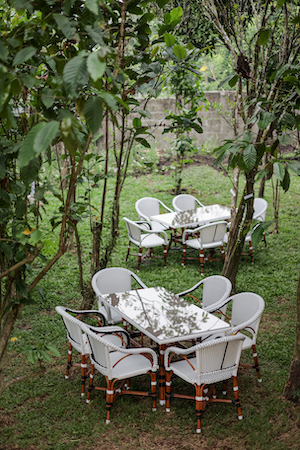
Even with its interiors, the restaurant makes sure to apply its core virtue of sustainability. The hardwood tables are all locally sourced, with some tables coming from their former Silang location.
The property extends farther to the back, with a full forest-type alfresco area where they plant some of the fresh produce that makes its way onto our plates. There are several flowering trees and native plants on the property, including a real coffee tree whose petals are an ingredient in one of their signature cocktails.
A comeback feast of great portions
The Fatted Calf’s menu is a reflection of what they hold dear: community, sustainability, and flavor. A generous spread was prepared for all who were present during the restaurant’s reintroduction. A whopping ten dishes (plus what we thought was going to be two desserts) were served as a welcome back to the beloved restaurant.
The menu is heavily influenced by the available produce and protein around the area, which means lots of beef and interesting vegetables.

Before any of the dishes were rolled out, we were served a basket of fresh bread—baked in house—with a side of locally sourced butter. The ingredients were all sourced from the nearby municipality of Alfonso. As a self-proclaimed butter devotee, the butter they served was stunning. It was rich, lucious, and flavorful with a light dusting of flaky salt on top.
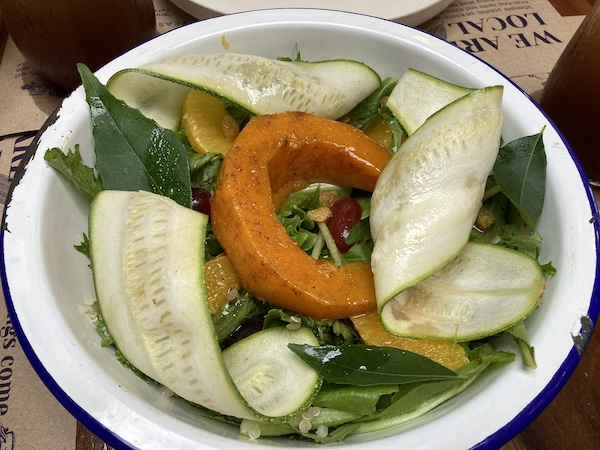
Two salads were served during the pleasurably lengthy lunch—and they weren’t your basic iceberg lettuce type of salad. The vegan glow salad, an old favorite from the previous location, was served first. It’s a vegan salad made with local, soil-grown greens, sesame-maple dressing, and gigantic wedges of roast squash.
The second salad was the smoked duck salad. Locally raised pekin ducks from a small farm in Tarlac were smoked in house to a medium doneness. The duck laid atop a bed of greens (tatsoi, mizuna and sakurab kimchi—also soil grown) and dried mango for a hint of sweetness.
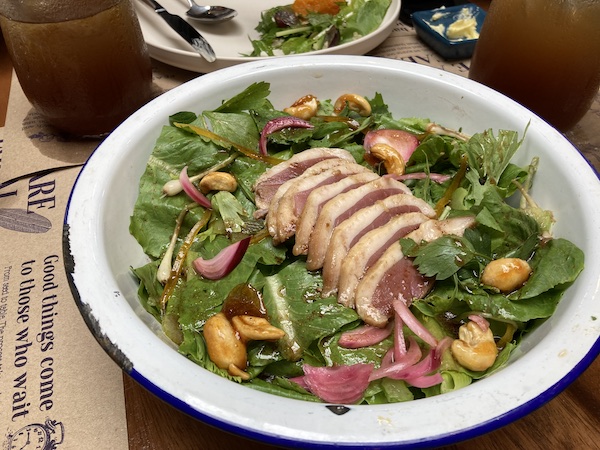
The first couple of appetizers that were served were seafood-based, sumptuous, and crave worthy. The first one, Vietnamese shrimp balls, were the restaurant’s riff on the traditional Vietnamese dish. It looks similar to takoyaki in appearance, but is very different in flavor.
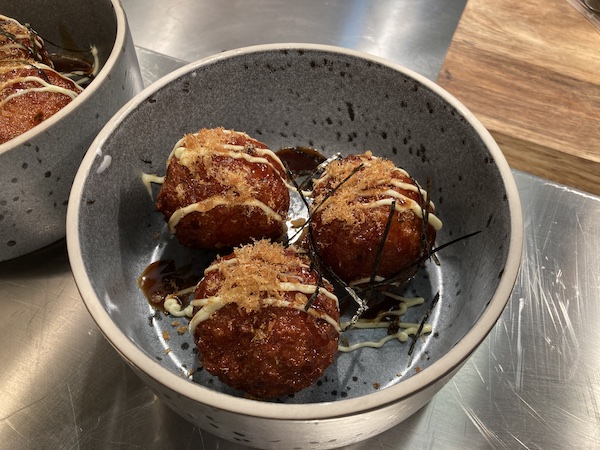
The balls are made with bouncy, succulent, sea-caught shrimp and topped with a creamy mayo and tonkatsu sauce, before finishing with a sprinkle of housemade fish floss.
The second appetizer was the cured fish. Cod was the cured protein of choice, which was topped with a drizzle of makrut oil and dabs of creme fraiche. The fish is tender, but still retains a bite due to the curing process and is finished with pickled red radish to provide a bit of zing to every bite.
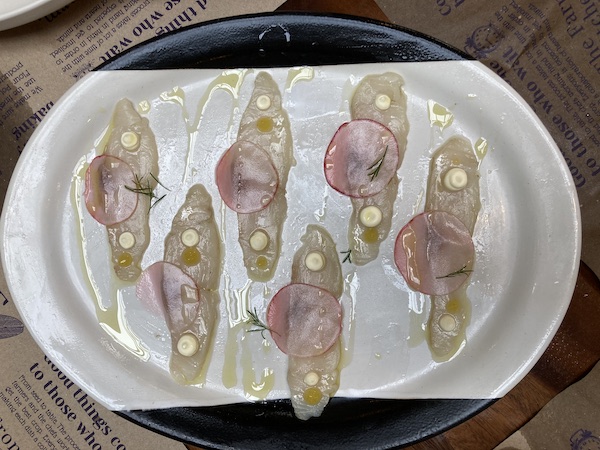
While most of the ingredients the restaurant uses is locally sourced, items like Australian wagyu were outsourced to make the best bite for their galbi bao. The galbi bao is an homage to the humble cuapao bun. The bun is stuffed to the brim with the sweet and semi-spicy wagyu and pickled vegetables to balance out its richness.
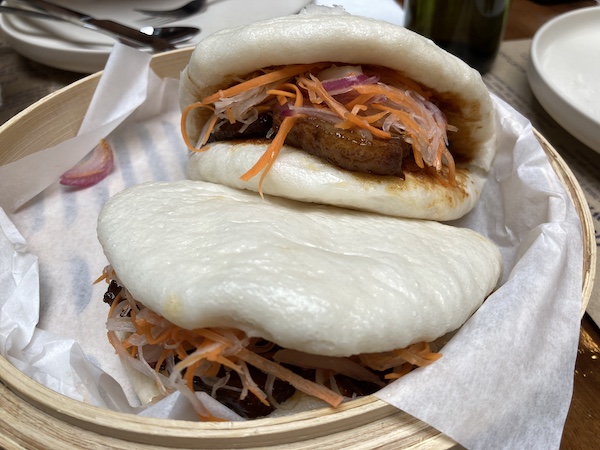
Aside from the Vietnamese shrimp balls, shrimp also makes its way to the pasta dish—where it’s rightfully the main ingredient. The shrimp spaghetti is a true comfort dish for seafood enthusiasts.
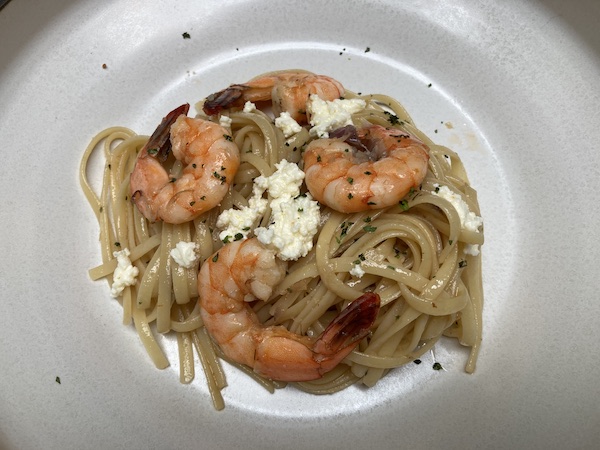
The pasta was cooked al dente in a brine of shrimp head oil with aromatics. It’s heavy on the shrimp flavor, which gets balanced out by the addition of brined kesong puti, makrut leaves, and karipatta.
The main(s) event
This specific meal at The Fatted Calf was indeed a marathon, not a sprint. After a whopping five dishes, there were still four more dishes to try and dessert. Aside from the quality and taste of the ingredients they use, hefty portions are another signature of the restaurant.
Four uniquely executed dishes are what make up the restaurant’s entrée section: fish and chips, red curry beef pot roast, thick-cut pork chop, and a locally grown, grass-fed, 10-hour roasted whole leg of beef.
The fish and chips is a classic, but the restaurant’s version uses catfish. The whole fish is fileted and dipped in a beer batter—which is the only way to do it, honestly. Deep, golden potato wedges are the fish’s co-star in this double header. The dish is served with two dips: black vinegar for the fish and miso aioli for the chips.
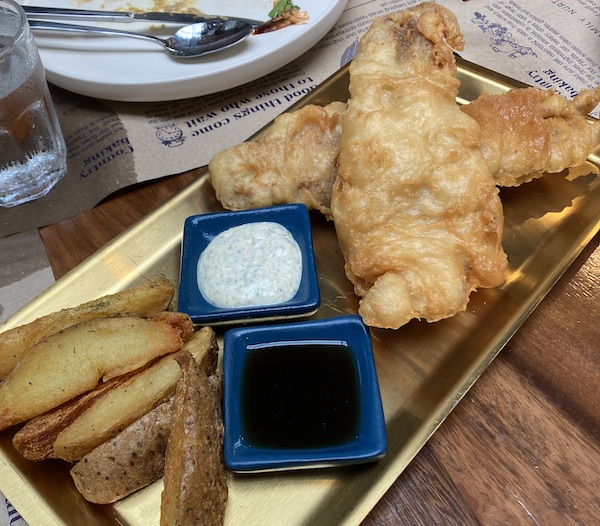
The fish is fried properly, which means the exterior is light and crisp while maintaining the tenderness inside. Black vinegar provides a necessary tang and burst of flavor for the relatively mildly flavored catfish.
For fans of South and Southeast Asian cuisine, the red curry beef pot roast is made from local grass-fed beef from Batangas. The beef is cooked in a red curry paste—made in house, of course—coconut milk, and lots of spices. The pot roast is also served with Benguet potatoes and eggplant to balance the meat with vegetables.
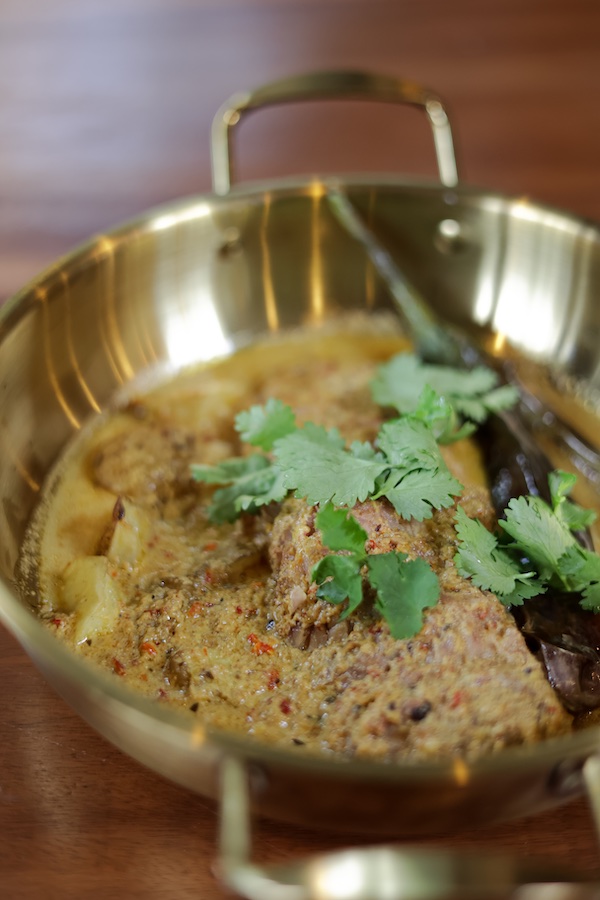
The red curry is a little spicy, which is to be expected. It’s finished with a light sprinkling of cilantro, which I was a very big fan of. The cilantro was a welcome addition, adding brightness and freshness to an otherwise very rich dish.
My personal pick of the day was the thick-cut pork chop—with lots of emphasis on the thick. In true Fatted Calf fashion, organic pork was used in the making of this dish. The pork is cut into approximately inch-thick slabs before being cooked up and served with Cebu-grown corn grits, apple sauce, and grilled corn wedges.
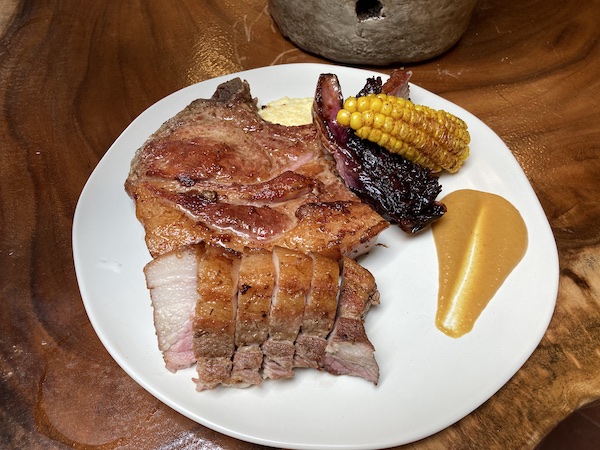
The resulting dish is a juicy, flavorful spectacle—best enjoyed with a little bit of everything in each bite.
The final dish of the day was a show stopping whole leg of beef. The beef shank is cooked for ten hours, which means this is a dish you can’t just order on whim. Prior to serving, the beef is finished in a drizzle of oil before being crisped up with a blowtorch. The beef is then served with an array of roasted vegetables and topped with a sauce of rum au jus.
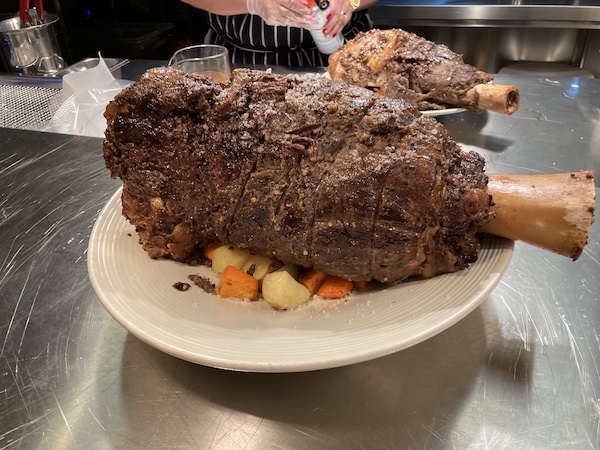
Fork-tender and fall of the bone come to mind when describing the dish. No knives were necessary to carve into the leg, which is a testament to the wonders of cooking low and slow. Each bite was rich, tender, and a perfect way to end the savory portion of the day.
A world of sweetness
Something else The Fatted Calf takes pride in is their cakes and breads. What we thought were going to be two desserts to tie off the day turned out to be five: chocolate cake, strawberry shortcake, mazapan de pili cheesecake, ube kinampay, and a surprisingly welcome pandemic throwback, a fresh strawberry donut.
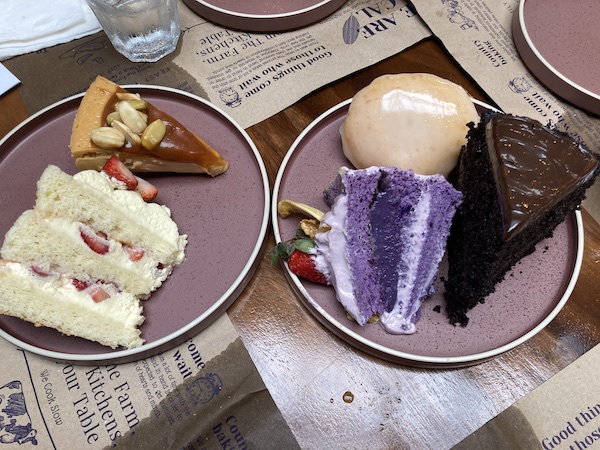
Each cake was delicious in its own right, but the two that stood out the most were the mazapan de pili cheesecake and the seasonal ube kinampay. The pili cheesecake is for nut and caramel lovers (which I am). The pili is sourced from Naga and makes its way into the creamy cheesecake through the crust and as whole toppings.
The ube kinampay is an upgraded version of all the ube cakes I’ve tried in the past. The ube flavor is deeper and more prominent, thanks to the special variety of ube harvested from Panglao once a year. The cake itself was a fluffy, airy affair layered with a decadent ube cream. It was simply delicious.
The restaurant that community rebuilt
It’s easy to see why The Fatted Calf was one of the restaurants that came back after the harshest periods of the pandemic and all of their other hurdles. Aside from serving delicious fare, there’s also something else in every bite: love.
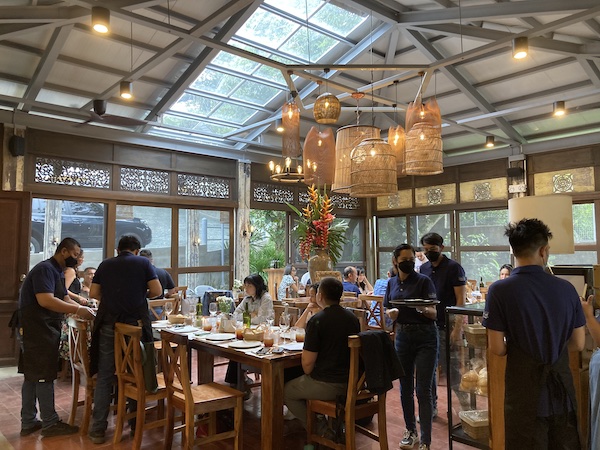
The SyCip’s are talented chefs, yes, but they are also passionate about everything that goes into their food and the community that helped them. There’s a sense of mindfulness and care that’s embedded into the ecosystem they’ve built for The Fatted Calf, and even a new diner like myself can recognize it from a mile away.
Caring is one of the things that truly sets The Fatted Calf apart. They care about the ingredients, the people around them, and the community that they’ve gathered through the food they serve. It only makes sense that the same community that they fed helped them come back—stronger than ever.
The Fatted Calf is located on the Tagaytay-Batangas Highway, Tagaytay and is open daily from 7 a.m. to 9 p.m., starting June 1.


